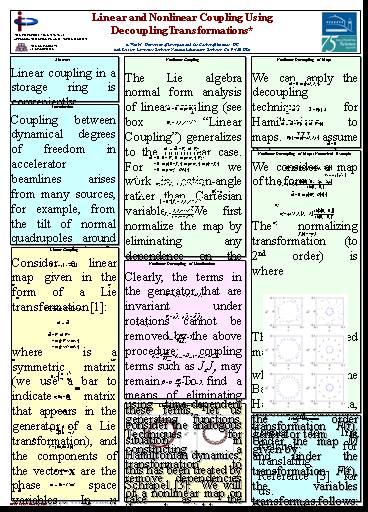Linear and Nonlinear Coupling Using Decoupling Transformations* - PowerPoint PPT Presentation
1 / 1
Title:
Linear and Nonlinear Coupling Using Decoupling Transformations*
Description:
... canonical transformation F can be written in Lie operator form as: where f is a ... The Lie algebra normal form analysis of linear coupling (see box 'Linear ... – PowerPoint PPT presentation
Number of Views:36
Avg rating:3.0/5.0
Title: Linear and Nonlinear Coupling Using Decoupling Transformations*
1
Linear and Nonlinear Coupling UsingDecoupling
Transformations A. Wolski, University of
Liverpool and the Cockcroft Institute, UKA.M.
Sessler, Lawrence Berkeley National Laboratory,
Berkeley, CA 94720, USA
THE COCKCROFT INSTITUTE of ACCELERATOR SCIENCE
AND TECHNOLOGY
THE UNIVERSITY of LIVERPOOL
Abstract Linear coupling in a storage ring is
conveniently analyzed in terms of transformations
that put the single-turn map into block-diagonal
form. Such a transformation allows us to define
new variables, in which the dynamics are
uncoupled. In principle, a similar approach may
be taken to nonlinear coupling we discuss such
an approach in this paper, giving some simple
illustrations of the ideas, based on the
well-known techniques of normal form analysis.
Introduction Coupling between dynamical degrees
of freedom in accelerator beamlines arises from
many sources, for example, from the tilt of
normal quadrupoles around the beam axis, or from
a vertical offset of the beam in a sextupole. The
presence of coupling complicates the description
of the dynamics. For example, consider the phase
space picture drawn by a particle making multiple
turns through a storage ring. If the motion is
uncoupled, the phase space coordinates of the
particle in any plane lie on a smooth ellipse
the area of each ellipse corresponds to a
conserved quantity of the motion. The existence
of such conserved quantities in symplectic
systems is an expression of Liouvilles theorem.
With coupling, the ellipses become irregular, and
the conserved quantities no longer correspond to
simple geometric quantities. The dynamics may be
simplified by making a coordinate transformation
in which the motion becomes uncoupled.
Symplecticity is preserved if the coordinate
transformation is canonical. If the motion is
fully decoupled by the transformation, the phase
space trajectory of a particle describes a smooth
ellipse in each plane as before, and the
conserved quantities required by Liouvilles
theorem again correspond to the areas of the
ellipses. In the case of linear coupling, it is
well known how to find a canonical tranformation
to new coordinates in which the motion is
uncoupled. For nonlinear coupling, the question
is a little more complicated, and new features
are introduced. In this paper, we consider the
use of Lie algebra methods for constructing
decoupling transformations in the linear and
nonlinear cases. The results provide some insight
into the nature of the dynamics in systems with
nonlinear coupling.
Acknowledgement Thanks to Ina Reichel for
translating Reference 3 for us. References 1
A. Dragt, Lie Maps, in Handbook of Accelerator
Physics and Engineering, A.W. Chao and M. Tigner
(editors), World Scientific (1999) 76-82. 2 E.
Forest, Beam Dynamics, a New Attitude and
Framework, Harwood Academic Publishers (1998),
149-163. 3 H.D. Schräpel, Entkopplung
Nichtlinearer Schwingungen, Ingenieur-Archiv 48
(1979) 289-300. 4 H. Goldstein, Classical
Mechanics, Addison-Wesley (1980),
378-390. This work was supported by the
Director, Office of Science, High Energy Physics,
US Department of Energy under contract number
DE-AC02-05CH11231. a.wolski_at_dl.ac.uk
EPAC 2006, Edinburgh, UK.































